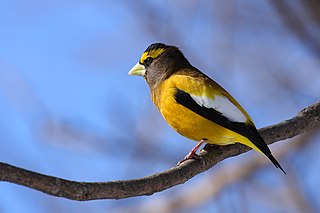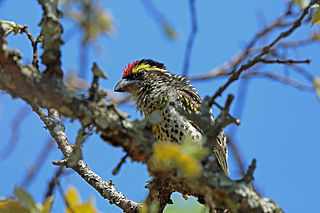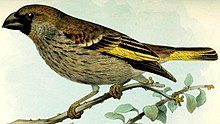
The black-winged stilt is a widely distributed very long-legged wader in the avocet and stilt family (Recurvirostridae). The scientific name H. himantopus is sometimes applied to a single, almost cosmopolitan species. Alternatively, it is restricted to the form that is widespread in Europe, Asia and Africa, which equals the nominate group of Himantopus himantopussensu lato. Most sources today accept 1–4 species. The scientific name Himantopus comes from the Greek meaning "strap foot" or "thong foot".

The evening grosbeak is a passerine bird in the finch family Fringillidae found in North America.

The rose-breasted grosbeak, colloquially called "cut-throat" due to its coloration, is a large, seed-eating grosbeak in the cardinal family (Cardinalidae). It is primarily a foliage gleaner. Males have black heads, wings, backs, and tails, and a bright rose colored patch on their white breast. Males and females exhibit marked sexual dimorphism.

The ruddy-headed goose is a species of waterfowl in tribe Tadornini of subfamily Anserinae. It is found in Argentina, Chile, and the Falkland Islands.

The Caucasian grouse or Caucasian black grouse is a large bird in the grouse family. It is closely related to the black grouse.

The Japanese grosbeak or Ikaru is a finch native to the East Palearctic. It is also sometimes referred to as the Japanese or masked hawfinch due to superficial similarities to the well-known Eurasian species.

Grosbeak is a form taxon containing various species of seed-eating passerine birds with large beaks. Although they all belong to the superfamily Passeroidea, these birds are not part of a natural group but rather a polyphyletic assemblage of distantly related songbirds. Some are cardueline finches in the family Fringillidae, while others are cardinals in the family Cardinalidae; one is a member of the weaver family Ploceidae. The word "grosbeak", first applied in the late 1670s, is a partial translation of the French grosbec, where gros means "large" and bec means "beak".

The collared plover is a small shorebird in the plover family, Charadriidae. It lives along coasts and riverbanks of the tropical to temperate Americas, from central Mexico south to Chile and Argentina.

The black-headed grosbeak is a medium-sized, seed-eating bird in the same family as the northern cardinal, the Cardinalidae. It is sometimes considered conspecific with the rose-breasted grosbeak with which it hybridizes on the American Great Plains.

The Réunion cuckooshrike is a passerine bird in the cuckooshrike family. It is endemic to the island of Réunion, where it is restricted to two areas of mountain forest in the north of the island. Males are dark grey above and pale grey beneath, while females have dark brown upper parts and a streaked breast. The population has been declining and the range contracting, being currently about 16 square kilometres (6.2 sq mi), and the International Union for Conservation of Nature has rated the species as "critically endangered", with the possibility that the bird could be wiped out by a tropical storm. Conservation efforts are being made by attempting to control the cats and rats which prey on the chicks, and this seems to have resulted in the population stabilising.

The genus Rhynchostruthus is a small group of finches in the family Fringillinae. Commonly known as golden-winged grosbeaks, they are attractive, chunky, medium-sized, robust-billed songbirds restricted to the southern Arabian and northern Somalian regions.

The Bengal florican, also called the Bengal bustard, is a bustard species native to the Indian subcontinent, Cambodia, and Vietnam. It is listed as Critically Endangered on the IUCN Red List because fewer than 1,000 individuals were estimated to be alive as of 2017. It is the only member of the genus Houbaropsis.

The golden grosbeak, also known as golden-bellied grosbeak or southern yellow grosbeak, is a species of grosbeak in the family Cardinalidae. It is similar to, and has sometimes been considered conspecific with, the yellow grosbeak.

The miombo pied barbet is a species of bird in the family Lybiidae. It is found in south-central Africa.

The Socotra buzzard is a medium to large bird of prey that is sometimes considered a subspecies of the widespread common buzzard. As its name implies, it is native to the island of Socotra, Yemen. Although it is listed as vulnerable in the IUCN Red List, its population is considered to be stable.

The Socotra Island xeric shrublands is a terrestrial ecoregion that covers the large island of Socotra and several smaller islands that constitute the Socotra Archipelago. The archipelago is the western Indian Ocean, east of the Horn of Africa and south of the Arabian Peninsula. Politically the archipelago is part of Yemen, and lies south of the Yemeni mainland.

The Somali golden-winged grosbeak or Somali grosbeak is a finch endemic to Somaliland. It is included as a subspecies in R. socotranus by some authorities, but in recent times the three golden-winged grosbeak populations are usually considered distinct species.

The Arabian golden-winged grosbeak or Arabian grosbeak is a finch found in Saudi Arabia, Oman and Yemen. It is included as a subspecies in R. socotranus by some authorities, but in recent times the three golden-winged grosbeak populations are usually considered distinct species.

The greenfinches are small passerine birds in the genus Chloris in the subfamily Carduelinae within the Fringillidae. The species have a Eurasian distribution except for the European greenfinch, which also occurs in North Africa.

The Abd al-Kuri sparrow is a passerine bird endemic to the small island of Abd al Kuri in the Socotra archipelago of the Indian Ocean, off the Horn of Africa. Though this species was originally described as a distinct species, it was considered conspecific with the Socotra sparrow. A study by Guy Kirwan showed significant differences from the Socotra sparrow, and that the two sparrows might even have different origins. On the evidence that it is morphologically distinct, BirdLife International recognised it as a species, and it was listed in the IOC World Bird List from December 2009. It has a very restricted distribution, and a population of under 1,000 individuals, so despite not having any known threats it is considered a Vulnerable species on the IUCN Red List.





















